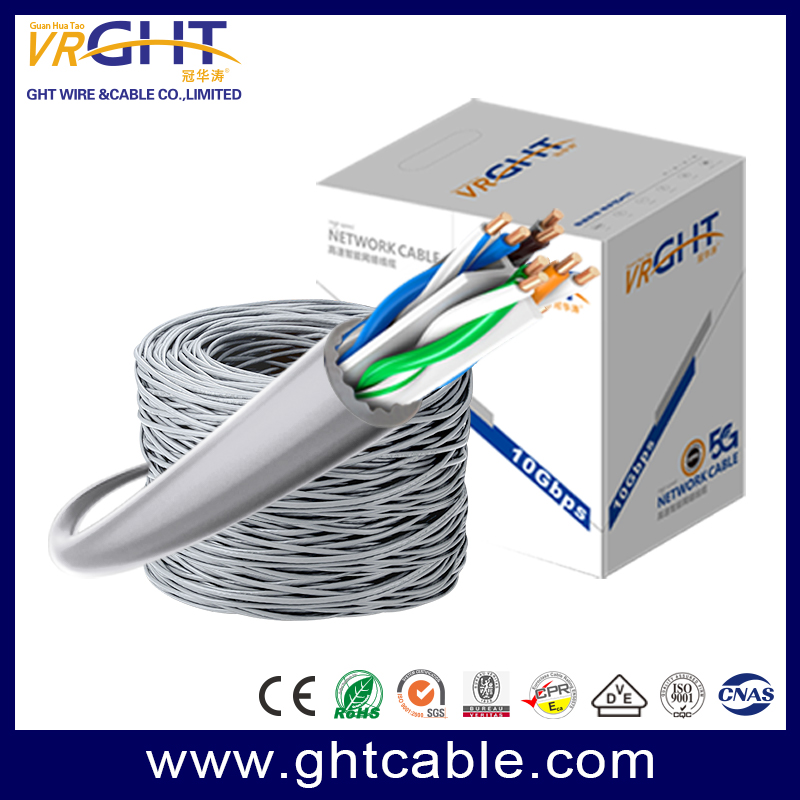
Cat5 Vs Cat6 Vs Cat7 Network Cables: What Is The Difference?
In an era where fast and reliable internet is essential for work, entertainment, and communication, choosing the right Ethernet cable matters more than ever. Whether you're building a home network or upgrading enterprise infrastructure, understanding the differences between Cat5, Cat6, and Cat7 network cables will help you make a smarter, future-proof investment.
In this guide, we'll break down each cable category's performance, shielding, use cases, and ideal application environment. As a trusted cable supplier, VRGHT offers a wide range of Ethernet cable solutions designed for stability, speed, and long-term performance.
What Are Ethernet Cable Categories?
Ethernet cables are classified into categories — abbreviated as "Cat" — that reflect technical specifications including data transfer speeds, bandwidth frequency, and shielding design. With each newer category, improvements have been made in terms of faster communication, reduced signal interference, and better performance over long distances.
Let's explore the differences in detail.
Cat5: The First Mainstream Standard
Category 5 (Cat5) was the industry standard for Ethernet networking in the late 1990s and early 2000s. While largely obsolete today, Cat5 played an important role in the foundation of wired networking.
Key Characteristics:
Speed Support: Up to 100 Mbps
Bandwidth: 100 MHz
Maximum Length: 100 meters (328 feet)
Shielding: Typically unshielded twisted pair (UTP)
Connector: Standard RJ45
Pros:
- Cost-effective when it was introduced
- Adequate for early internet use and VoIP phones
- Compatible with legacy hardware
Limitations:
- Not suitable for modern Gigabit Ethernet or high-bandwidth applications
- Susceptible to signal degradation and electromagnetic interference
- Lacks the improved internal structure of newer cable types
Cat5 has now been fully replaced by Cat5e (enhanced), which offers Gigabit speeds and reduced crosstalk. At VRGHT, we no longer recommend Cat5 cables for new installations but can offer Cat5e alternatives that provide better performance at a similar cost.
Cat6: Built for Gigabit Networking
Category 6 (Cat6) represents a significant performance upgrade from Cat5e. Introduced in the mid-2000s, Cat6 is now a popular standard for both residential and commercial networking systems.
Key Characteristics:
Speed Support: Up to 10 Gbps (for up to 55 meters)
Bandwidth: 250 MHz
Maximum Length: 100 meters (at 1 Gbps)
Shielding Options: Available in UTP (unshielded) and STP (shielded) versions
Connector: Standard RJ45
Advantages:
- Handles more bandwidth, allowing faster data transmission
- Reduced crosstalk due to tighter pair twisting
- Supports Gigabit Ethernet and limited 10 Gigabit applications
- Backward-compatible with Cat5 and Cat5e systems
Use Cases:
- Modern home networks with streaming and gaming devices
- Small to mid-sized businesses
- Office setups with PoE (Power over Ethernet) requirements
- Surveillance systems with IP cameras
At VRGHT, our Cat6 Ethernet cables are designed with premium copper conductors and durable jackets. We provide both unshielded and shielded versions to ensure superior performance in all kinds of environments, from home installations to industrial wiring.
Cat7: Professional Grade Performance
Category 7 (Cat7) cables are designed for high-speed, high-bandwidth applications where interference resistance and signal integrity are critical. While still using RJ45 connectors for compatibility, Cat7 cables incorporate advanced shielding technology.
Key Characteristics:
Speed Support: Up to 10 Gbps (full distance)
Bandwidth: 600 MHz
Maximum Length: 100 meters
Shielding: S/FTP (individually shielded pairs + overall foil shield)
Connector: RJ45 (or GG45/TERA for some installations)
Advantages:
- Maximum noise resistance and low signal loss
- Excellent for EMI-heavy environments
- Maintains speed and stability over long distances
- Ideal for advanced networking environments such as data centers
Use Cases:
- Server farms and data centers
- High-density network installations
- Environments with heavy electromagnetic interference (e.g., hospitals, factories)
- Applications requiring consistent 10 Gbps transfer across long runs
VRGHT's Cat7 cables are manufactured to meet the highest industry standards, combining precision shielding with backward-compatible RJ45 connectors. For professional-grade performance, our Cat7 line is trusted by IT integrators, builders, and telecom engineers worldwide.
Cat5 vs Cat6 vs Cat7: How to Choose the Right Cable?
Now that you understand each cable category, how do you decide which is right for your project? The decision depends on your specific needs in terms of speed, budget, and installation environment.
1. Budget and Basic Usage
If you're looking for a simple, cost-effective solution for internet browsing, email, or casual streaming, Cat5e is still a valid option. It supports 1 Gbps speeds and is widely available at an affordable price.
2. Mid-Range Performance and Futureproofing
Cat6 offers the best balance between performance and price. It supports 10 Gbps over shorter distances and is ideal for most home and small office networks. If you're upgrading a legacy system or planning a long-term installation, Cat6 is a smart choice.
3. High-Performance and Critical Environments
For ultra-reliable, high-speed data transmission with superior shielding, Cat7 is the answer. It's best suited for installations where stability and performance under load are non-negotiable — such as data centers or smart buildings.
Why Choose VRGHT for Your Network Cabling Needs?
When it comes to Ethernet cables, performance, quality, and trust are essential. At VRGHT, we deliver more than just cables — we provide total connectivity solutions for professionals, contractors, and distributors around the world.
Here's what makes VRGHT different:
Premium Materials: Our cables use 100% pure copper conductors, ensuring efficient signal transmission and long-term durability.
Global Compliance: All products are tested and certified to meet international standards, including ISO, RoHS, CE, and UL.
Customization Options: From bulk orders to customized lengths, jacket colors, and labeling, VRGHT supports a variety of project needs.
Technical Expertise: Our team provides pre-sale consultation and post-sale support to ensure every installation goes smoothly.
Reliable Delivery: With strategic logistics networks, we offer timely, secure shipping to clients worldwide.
Whether you need Cat5e patch cords, Cat6 bulk cables, or shielded Cat7 lines for high-end infrastructure, VRGHT has the solution to support your success.
Conclusion
Understanding the distinctions between Cat5, Cat6, and Cat7 network cables allows you to make informed decisions that directly affect network speed, stability, and long-term scalability. Each cable category serves a unique purpose — from basic residential setups to advanced industrial installations.
Choosing a reliable supplier is just as important as choosing the right cable. With VRGHT, you get high-quality products backed by technical expertise and a global reputation for service. Let us help you build the network infrastructure your project deserves.










Leave a comment